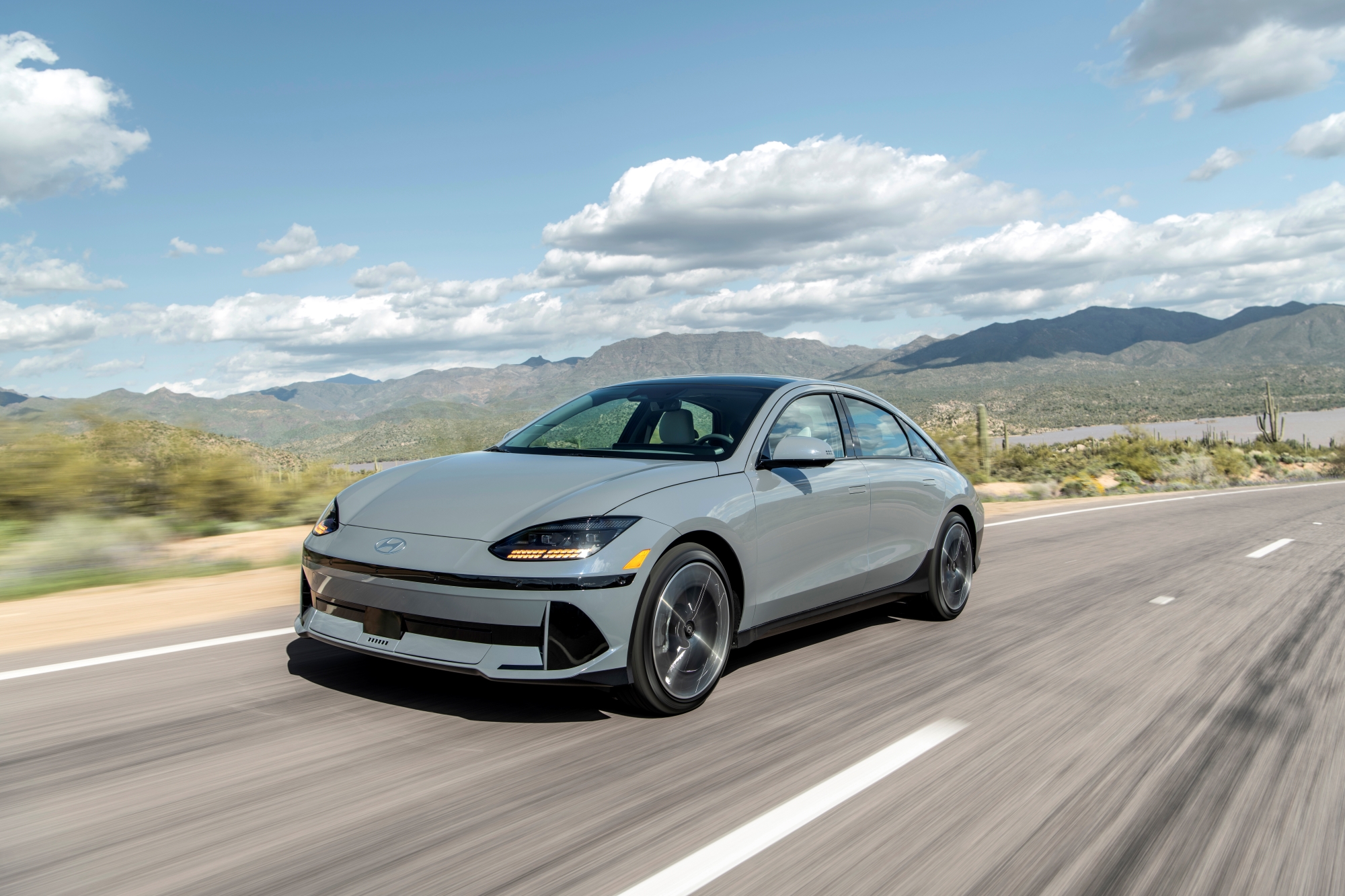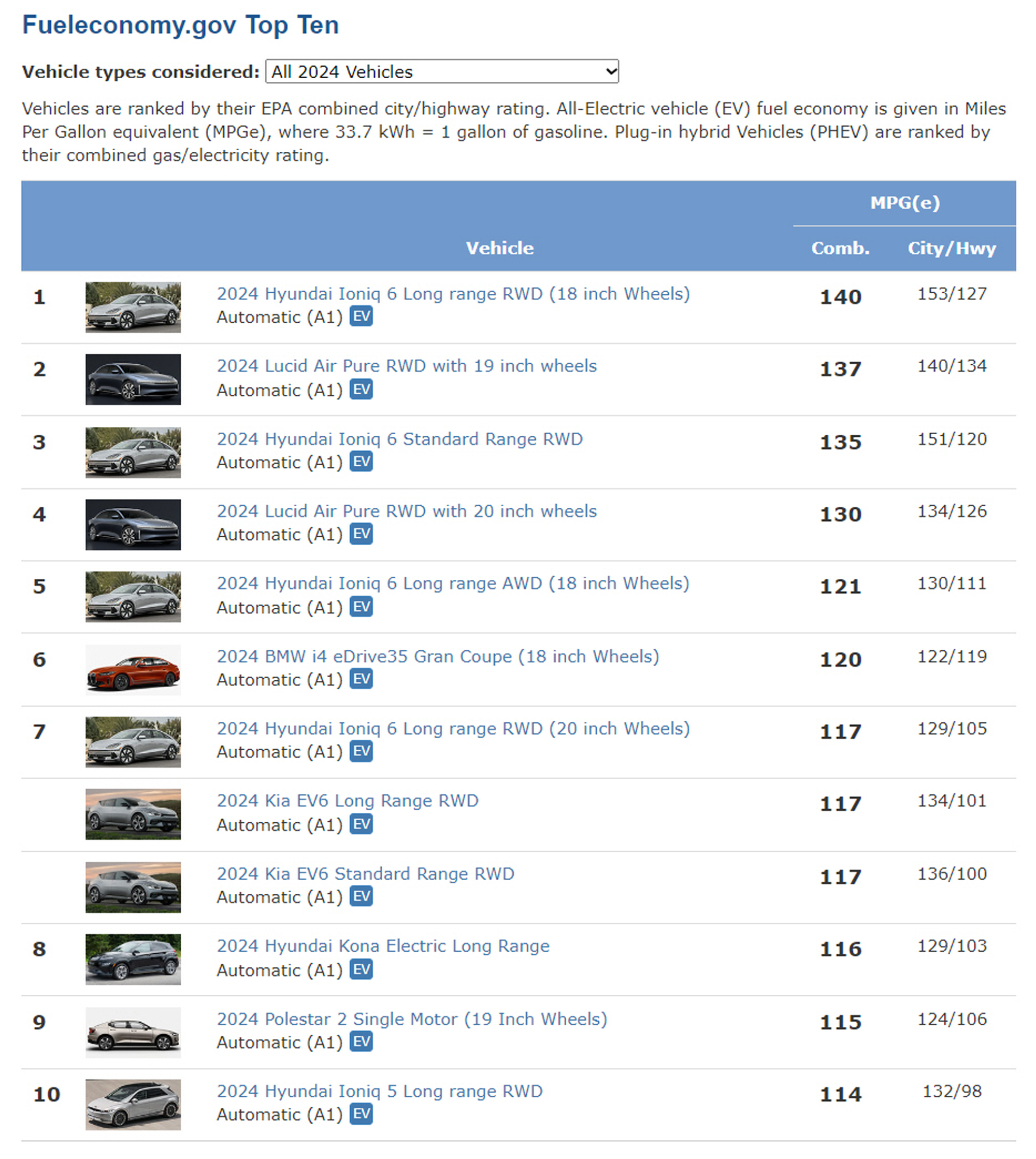
The Hyundai Ioniq 6 has emerged as the most fuel-efficient model among the new cars sold in the U.S. market for the 2024 model year.
According to Fueleconomy.gov, a fuel-saving information site jointly operated by the U.S. Department of Energy and the Environmental Protection Agency (EPA), the long-range rear-wheel-drive version of the Ioniq 6 (with 18-inch wheels and a combined efficiency of 140 MPGe) has topped the list of “Best Fuel Economy Vehicles.” The Ioniq 6, certified as a 2023 model, has claimed the first spot for the second consecutive year, earning it recognition from the EPA as an electric vehicle with the highest level of efficiency.
MPGe (Miles Per Gallon equivalent) is a unit of measurement for the fuel efficiency of electric vehicles used by the U.S. EPA, based on the fact that the thermal energy obtainable from burning one gallon of gasoline (approximately 3.785L) is equivalent to 33.7 kilowatt-hours (kWh). This provides a significant advantage in comparison to traditional internal combustion engines, as it allows for easier comparison of fuel consumption efficiency.
For instance, the gasoline model of the Kona with a 2.0L engine achieves 31 MPG, whereas the Kona Electric long-range version hits 116 MPGe. The ‘e’ added to the electric vehicle designation enables consumers to intuitively compare the energy efficiency of electric vehicles with that of internal combustion engines.
In this survey, not only did the Hyundai Ioniq 6 claim the top spot, but a total of four of its models made it into the top 10. The standard rear-wheel-drive model (135 MPGe) was ranked 3rd, the long-range all-wheel-drive model with 18-inch wheels (121 MPGe) took the 5th position, and the long-range rear-wheel-drive model with 20-inch wheels (117 MPGe) was listed 7th.
The fuel efficiency of the Ioniq 6 long-range rear-wheel-drive model (140 MPGe, based on 18-inch wheels) is five times higher than the average efficiency of new vehicles for the 2024 model year (28 MPGe). According to Fueleconomy, owning this model for five years would save approximately $6,000 (about 8 million KRW) in fuel costs compared to the average. (Based on annual driving of 15,000 miles, 55% city, 45% highway, at $3.27 per gallon) The Ioniq 6 rear-wheel drive model can travel up to 361 miles (approximately 580 km) on a full charge.
Additionally, the Kia EV6 long-range and standard rear-wheel-drive models (117 MPGe) also tied for 7th place, while the Hyundai Kona Electric long-range version (116 MPGe) came in 8th, and the Hyundai Ioniq 5 long-range rear-wheel-drive model (114 MPGe) secured the 10th position. The fact that eight out of the top 10 fuel-efficient vehicles counted by U.S. governmental agencies are Korean electric vehicles demonstrates the competitiveness of Korean-made electric vehicles on a public scale.
In contrast, Tesla has yet to report the fuel economy of its 2024 models to the EPA. The 2023 model year shows the Model 3 (132 MPGe) and Model Y (123 MPGe) performing similarly or slightly below the Ioniq 6. However, considering that the expected driving ranges for the 2024 Model 3 and Model Y listed on Tesla’s official U.S. website are projected to decrease by 17 miles (approximately 27 km) and 20 miles (approximately 32 km) respectively compared to the 2023 models, a decrease in fuel economy is also anticipated.
Prior to this, the automotive review website Edmunds published results of its electric vehicle driving distance evaluations. The long-range rear-wheel-drive model of the Ioniq 6 topped the chart with a driving distance of 868 miles after 1-hour charging. Following in second place was the rear-wheel-drive model of the EV6 (769 miles, about 1,238 km), and in third place was the all-wheel-drive model of the Ioniq 6 (764 miles, about 1,230 km), further highlighting the superior quality of Korean electric vehicles.
Market experts predict that with the global trend toward stricter environmental regulations, Korean vehicles with competitive fuel efficiency will have an advantage over competing manufacturers.
In fact, the U.S. government announced plans last July to strengthen the average fuel economy for passenger cars and light trucks sold locally to 58 MPG (about 24.6 km/L) by 2032.
The European Union (EU) and the European Parliament also reached a preliminary agreement on stricter automobile emissions standards known as “Euro 7” at the end of last year. Unlike Euro 6, which solely measured emissions from internal combustion engines, Euro 7 introduces emissions standards for particulates generated from the wear of tires, brake pads, and other components for the first time. Consequently, electric vehicles and hydrogen fuel-cell vehicles, which do not emit exhaust gases, will also be subject to Euro 7 regulations.
In South Korea, the Korea Energy Agency that handles vehicle fuel economy certification has reportedly launched a study on the “Improvement Plan for Fuel Economy Display.” With the introduction of Korea’s MPGe measurement system, the comparative advantage of electric vehicles over internal combustion engines will likely become more evident.

Lee Sang-jin daedusj@autodiary.kr

